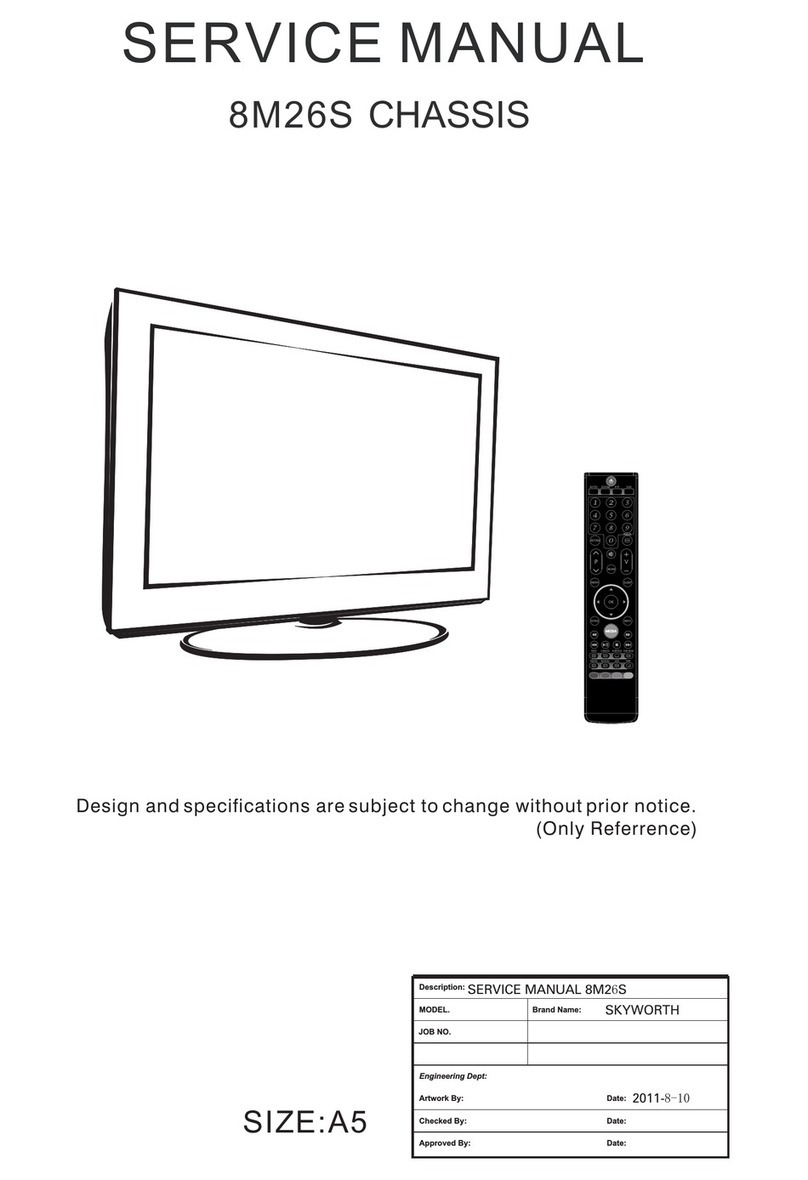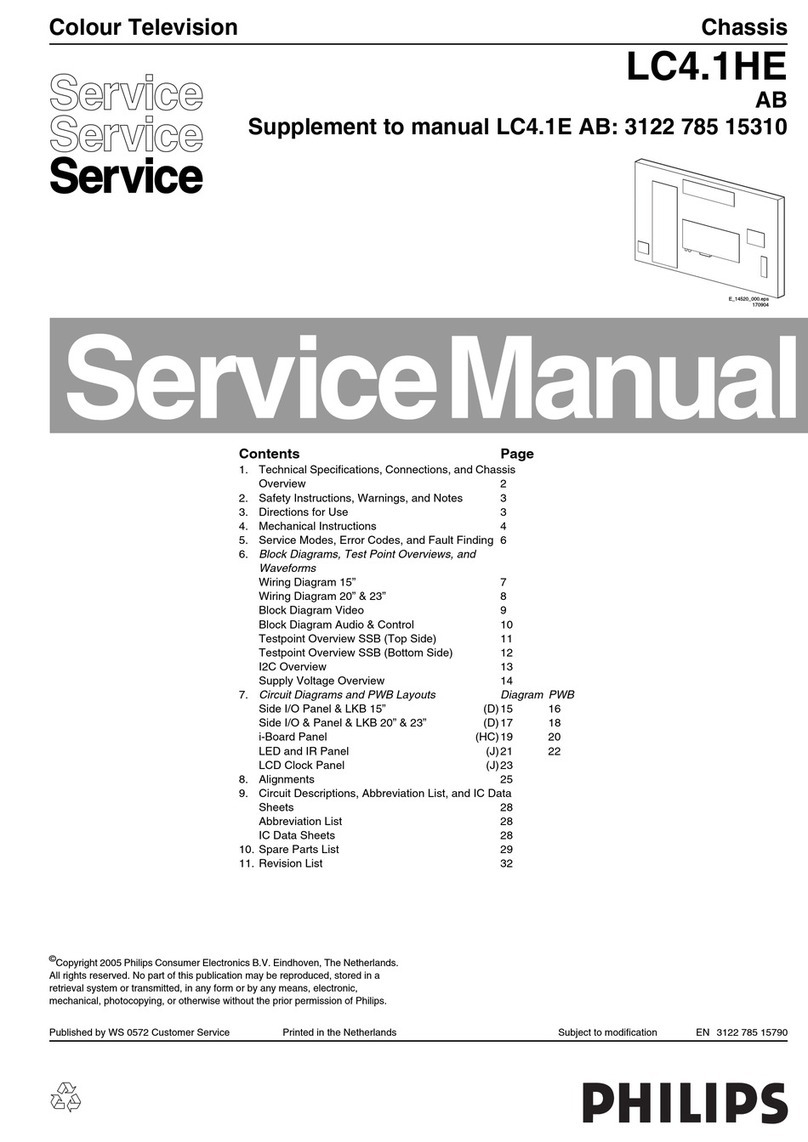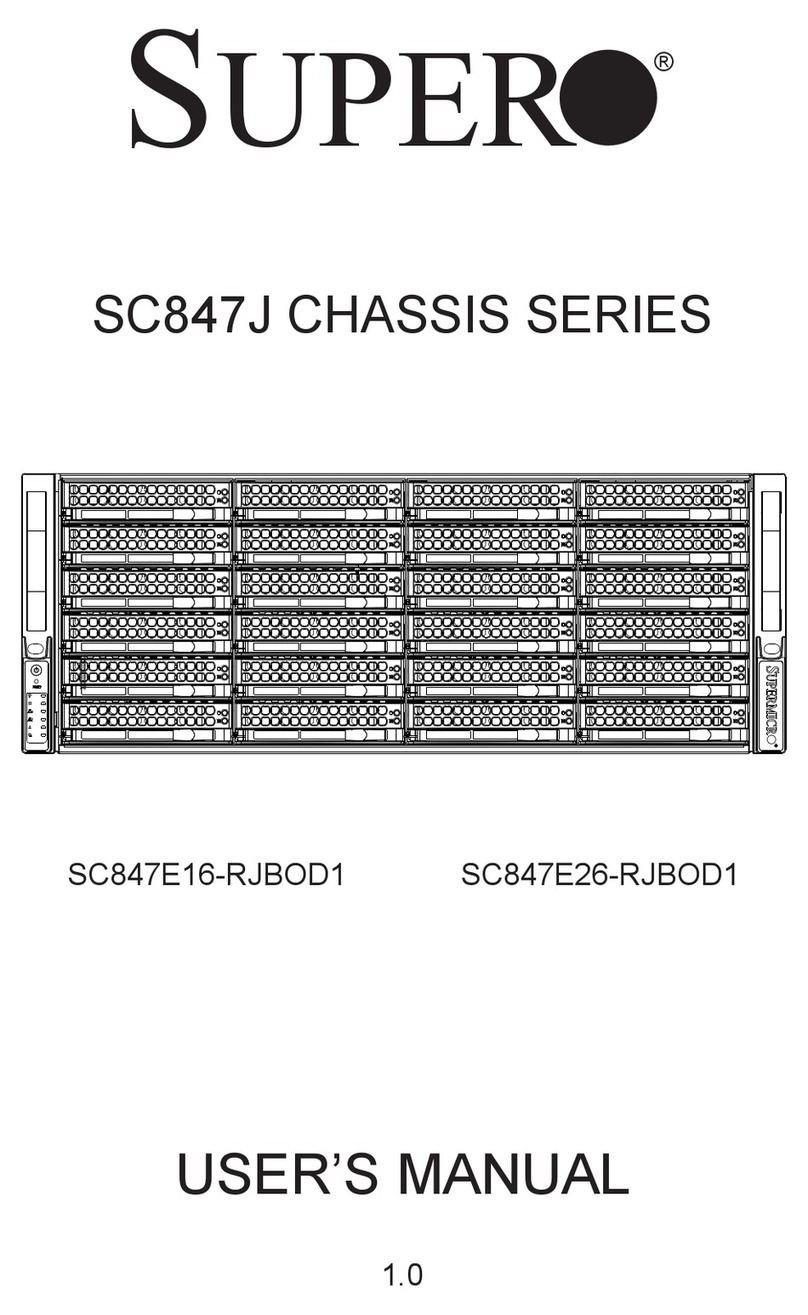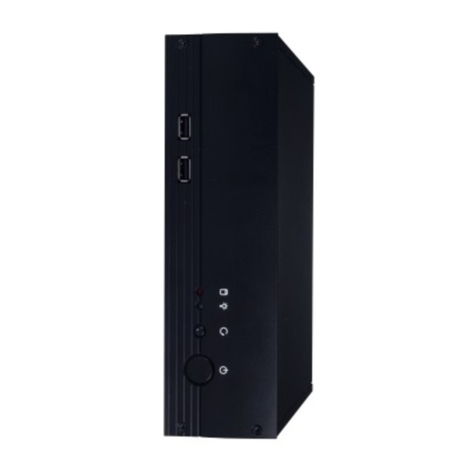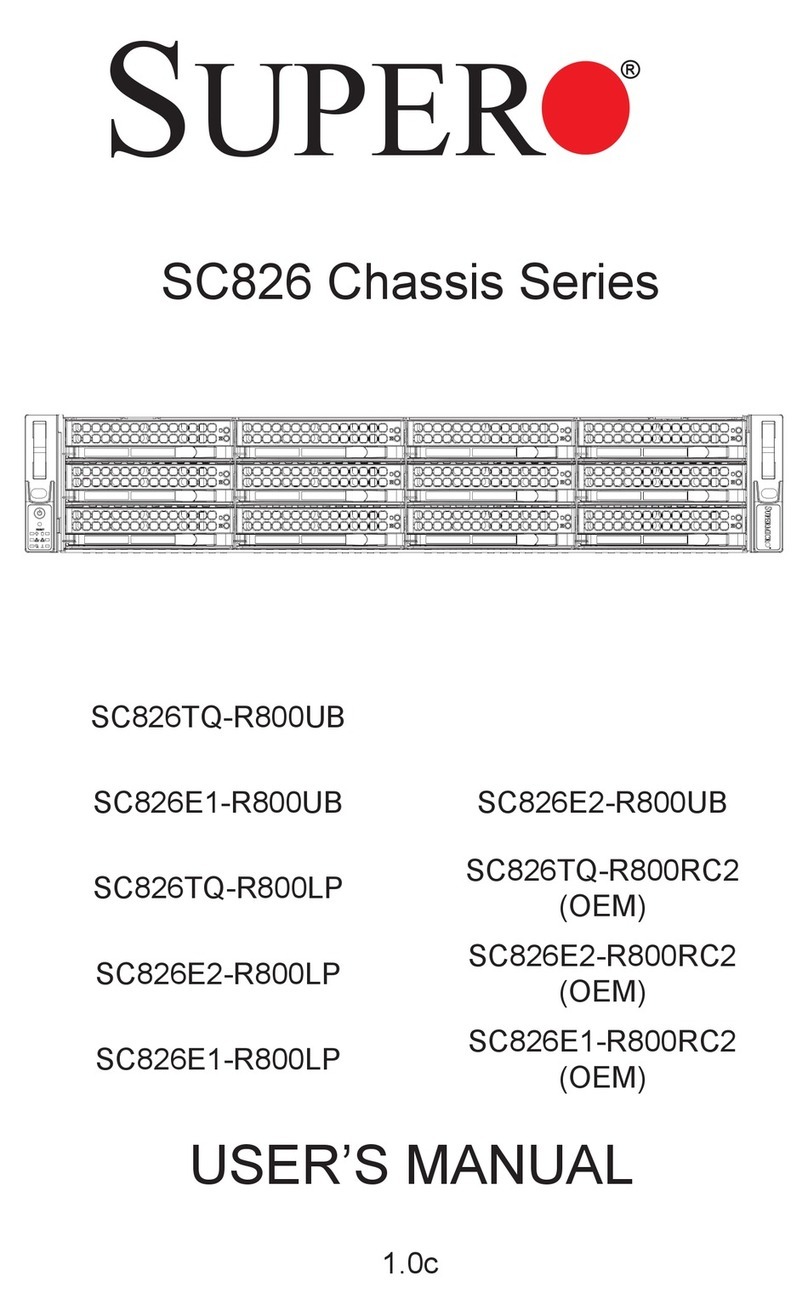BELL LABS INNOVATIONS Lucent Technologies Stinger MS+ User manual

Stinger®MS+
Getting Started Guide
Part Number: 363-217-002R9.7
For software version 9.7.0
August 2004

Lucent Technologies
Copyright © 2004 Lucent Technologies Inc. All rights reserved.
This material is protected by the copyright laws of the United States and other countries. It may not be reproduced, distributed, or altered in
any fashion by any entity (either internal or external to Lucent Technologies), except in accordance with applicable agreements, contracts, or
licensing, without the express written consent of Lucent Technologies. For permission to reproduce or distribute, please email your request to
techcomm@lucent.com.
Notice
Every effort was made to ensure that the information in this document was complete and accurate at the time of printing, but information is
subject to change. For latest information, refer to online product documentation at www.lucent.com/support.
European Community (EC) RTTE compliance
Hereby, Lucent Technologies, declares that the equipment documented in this publication is in compliance with the essential require-
ments and other relevant provisions of the Radio and Telecommunications Technical Equipment (RTTE) Directive 1999/5/EC.
To view the official Declaration of Conformity certificate for this equipment, according to EN 45014, access the Lucent INS online documentation
library at http://www.lucentdocs.com/ins.
Safety, compliance, and warranty Information
Before handling any Lucent Access Networks hardware product, read the Edge Access and Broadband Access Safety and Compliance Guide included
in your product package. See that guide also to determine how products comply with the electromagnetic interference (EMI) and network
compatibility requirements of your country. See the warranty card included in your product package for the limited warranty that Lucent
Technologies provides for its products.
Security statement
In rare instances, unauthorized individuals make connections to the telecommunications network through the use of access features.
Trademarks
Lucent, the Lucent logo, and all Lucent brand and product names are trademarks or registered trademarks of Lucent Technologies Inc. Other
brand and product names are trademarks of their respective holders.
Ordering Information
You can order the most up-to-date product information and computer-based training online at http://www.lucentdocs.com/bookstore.
Feedback
To comment on this information product, go to the Online Comment Form (http://www.lucent-info.com/comments/enus/) or email your comments
to the Comments Hotline (comments@lucent.com).

Customer Service
Stinger® MS+ Getting Started Guide iii
Customer Service
Product and service information, and software upgrades, are available 24 hours a day.
Technical assistance options accommodate varying levels of urgency.
Finding information and software
To obtain software upgrades, release notes, and addenda for this product, log in to
Lucent OnLine Customer Support at http://www.lucent.com/support.
Lucent OnLine Customer Support also provides technical information, product
information, and descriptions of available services. The center is open 24 hours a day,
seven days a week. Log in and select a service.
Obtaining technical assistance
Lucent OnLine Customer Support at http://www.lucent.com/support provides access
to technical support. You can obtain technical assistance through email or the
Internet, or by telephone. If you need assistance, make sure that you have the
following information available:
■Active service or maintenance contract number, entitlement ID, or site ID
■Product name, model, and serial number
■Software version
■Software and hardware options If supplied by your carrier, service profile
identifiers (SPIDs) associated with your line
■Your local telephone company’s switch type and operating mode, such as AT&T,
5ESS Custom or Northern Telecom National ISDN-1
■Whether you are routing or bridging with your Lucent product
■Type of computer you are using
■Description of the problem
Obtaining assistance through email or the Internet
If your services agreement allows, you can communicate directly with a technical
engineer through Email Technical Support or a Live Chat. Select one of these sites
when you log in to http://www.lucent.com/support.
Calling the technical assistance center (TAC)
If you cannot find an answer through the tools and information of Lucent OnLine
Customer Support or if you have a very urgent need, contact TAC. Access Lucent
OnLine Customer Support at http://www.lucent.com/support and click Contact Us
for a list of telephone numbers inside and outside the United States.
Alternatively, call 1-866-LUCENT8 (1-866-582-3688) from any location in North
America for a menu of Lucent services. Or call +1 510-747-2000 for an operator. You
must have an active services agreement or contract.


Stinger® MS+ Getting Started Guide v
Contents
Customer Service ........................................................................................................iii
About This Guide ..............................................................................xiii
What is in this guide .................................................................................................xiii
What you should know.............................................................................................xiii
Documentation conventions.....................................................................................xiii
Stinger documentation set ........................................................................................xiv
Chapter 1 Preparing for the Installation...........................................................1-1
Stinger MS+ overview.............................................................................................. 1-1
The Stinger MS+ chassis .................................................................................... 1-1
Modular plug-in components ............................................................................ 1-3
Selecting an installation site ..................................................................................... 1-3
Required tools and equipment................................................................................. 1-4
Preventing static discharge damage.......................................................................... 1-4
Use a wrist strap................................................................................................. 1-4
Remove plastics from your work area ............................................................... 1-6
Store components properly ............................................................................... 1-6
Unpacking the Stinger.............................................................................................. 1-6
Verifying the hardware configuration...................................................................... 1-6
Checking the front of the chassis....................................................................... 1-7
Verifying the control module model ........................................................... 1-7
Control module support .............................................................................. 1-8
Control module interfaces........................................................................... 1-8
Checking the LIMs ...................................................................................... 1-9
Checking the of the chassis.............................................................................. 1-10
Verifying the trunk module ...................................................................... 1-10
Checking the LPMs ................................................................................... 1-12
Chapter 2 Installing a Stinger MS+ ...................................................................2-1
Before you begin ...................................................................................................... 2-1
Mounting the unit.................................................................................................... 2-1
Connecting cables to a Stinger unit.......................................................................... 2-3
Connecting to the LPMs .................................................................................... 2-3
Securing the connectors .............................................................................. 2-3
Connecting the subscriber lines .................................................................. 2-4
Connecting the trunk modules.......................................................................... 2-5
Optical trunk module connections.............................................................. 2-5
DS3-ATM or E3-ATM trunk module connections ...................................... 2-5

vi Stinger® MS+ Getting Started Guide
Contents
Control module connections.................................................................................... 2-6
System clocking........................................................................................................ 2-7
Alarm monitoring .................................................................................................... 2-7
Connecting to monitor Stinger unit alarm status .............................................. 2-7
Connecting a Stinger unit to monitor the alarm status of other devices........... 2-8
Connections from the control module ........................................................ 2-8
What’s next .............................................................................................................. 2-9
Chapter 3 Determining the Operating Status ..................................................3-1
Before you begin ...................................................................................................... 3-1
Connecting power to a Stinger unit ......................................................................... 3-1
Turning on power to a Stinger unit ......................................................................... 3-2
Status lights .............................................................................................................. 3-3
Control module status lights.............................................................................. 3-3
LIM status lights................................................................................................. 3-5
Trunk module status lights ................................................................................ 3-5
Fan status light................................................................................................... 3-5
What’s next .............................................................................................................. 3-6
Chapter 4 Stinger Operational Overview.........................................................4-1
Stinger MS+ operation as a DSL access multiplexer ................................................ 4-1
Stinger ATM switching overview ............................................................................. 4-2
Stinger configuration overview................................................................................ 4-2
Control module configuration ........................................................................... 4-2
Line interface module (LIM) configuration ....................................................... 4-2
Trunk module configuration ............................................................................. 4-3
System clocking modes...................................................................................... 4-3
Stinger management features .................................................................................. 4-3
Using the command-line interface .................................................................... 4-3
Onboard flash memory and software updates................................................... 4-4
SNMP support.................................................................................................... 4-4
RADIUS support ................................................................................................ 4-4
Tracking system activity..................................................................................... 4-4
Verifying software and control module versions ........................................ 4-5
Status windows ........................................................................................... 4-5
What’s next .............................................................................................................. 4-5
Chapter 5 Configuring the Control Module and System Timing ....................5-1
Control module configuration overview.................................................................. 5-1
Administrative connections...................................................................................... 5-1
Serial connection to a console ........................................................................... 5-2
Network connection to a workstation console .................................................. 5-2
Connecting a dial-in backup management connection ..................................... 5-3
Backup management with an external modem.......................................... 5-3
Modem country codes................................................................................. 5-4
Backup management with an internal modem .......................................... 5-5
Logging into the control module.............................................................................. 5-6
Restricting administrative access .............................................................................. 5-7
Changing defaults for serial-port logins............................................................. 5-7
Changing the default admin password .............................................................. 5-8

Contents
Stinger® MS+ Getting Started Guide vii
Setting a Telnet password .................................................................................. 5-9
Providing a basic system IP configuration................................................................ 5-9
IP address syntax ............................................................................................. 5-10
Netmasks.......................................................................................................... 5-10
Subnets...................................................................................................... 5-10
Assigning the Ethernet IP addresses ................................................................ 5-12
Defining the soft IP interface ........................................................................... 5-12
Configuring a default route ............................................................................. 5-13
Verifying a LAN connection for administrators............................................... 5-14
Configuring system clocking .................................................................................. 5-14
Using the default (controller) clock source...................................................... 5-14
Using the BITS clock source............................................................................. 5-15
Loss of BITS signal indications and fall-back............................................. 5-15
Changing the BITS clock source................................................................ 5-16
Using a LIM or trunk module clock source ..................................................... 5-16
Configuring trunk ports as eligible clock sources...................................... 5-17
Typical trunk port clock source configurations ......................................... 5-17
Chapter 6 Installing and Removing Modules ...................................................6-1
Installation and replacement considerations............................................................ 6-1
Replacing and installing control modules ................................................................ 6-2
Removing a control module .............................................................................. 6-2
Installing a control module................................................................................ 6-3
Slot numbering and module placement................................................................... 6-5
Installing and replacing LIMs ................................................................................... 6-5
Installing a LIM.................................................................................................. 6-5
Replacing a LIM ................................................................................................. 6-5
Installing and replacing LPMs .................................................................................. 6-6
Installing an LPM............................................................................................... 6-6
Replacing an LPM .............................................................................................. 6-7
Installing and replacing PCMCIA cards.................................................................... 6-8
Replacing the cooling module.................................................................................. 6-8
Replacing a power filter ........................................................................................... 6-9
Replacing the alarm module .................................................................................. 6-10
Appendix A Stinger Intended Use ....................................................................... A-1
User line interfaces ...................................................................................................A-1
Network interfaces ...................................................................................................A-1
Control module interfaces........................................................................................A-2
Appendix B Cables and Connectors .................................................................... B-1
Diagnostic port and cable pinouts ............................................................................B-1
Alarm input port pinouts .........................................................................................B-2
Ethernet interface specifications ..............................................................................B-2
10BaseT cables ...................................................................................................B-3
100BaseT cables .................................................................................................B-3
LPM cable specifications...........................................................................................B-3
LPM two-wire cable specifications.....................................................................B-3
LPM four-wire cable specifications ....................................................................B-7

viii Stinger® MS+ Getting Started Guide
Contents
Appendix C Safety-Related Electrical, Physical, and Environmental
Information ................................................................................. C-1
Electrical and electronic information .......................................................................C-1
Electronic and electrical specifications...............................................................C-1
USOC jack and code information ......................................................................C-2
EMI class ............................................................................................................C-3
Minimum ground wire size ...............................................................................C-3
Physical specifications ..............................................................................................C-3
Site specifications .....................................................................................................C-4
Operating environment .....................................................................................C-4
Space requirements ...........................................................................................C-5
Special requirements and recommendations for installation and maintenance ...... C-5
Lifting requirements ..........................................................................................C-5
Index .......................................................................................... Index-1

Stinger® MS+ Getting Started Guide ix
Figures
Figure 1-1 The Stinger MS+ (front view) ........................................................... 1-2
Figure 1-2 The Stinger MS+ (rear view)............................................................. 1-2
Figure 1-3 Wrist grounding strap ....................................................................... 1-5
Figure 1-4 Wrist strap plugged into a grounding jack ........................................ 1-5
Figure 1-5 The Stinger MS+ (front view) ........................................................... 1-7
Figure 1-6 Model B control module interfaces................................................... 1-9
Figure 1-7 The Stinger MS+ (rear view)........................................................... 1-10
Figure 1-8 OC3-ATM trunk module fiber optic connection points .................. 1-11
Figure 1-9 OC12-ATM trunk module fiber optic connection points ................ 1-11
Figure 1-10 DS3-ATM or E3-ATM trunk module connection points................. 1-11
Figure 1-11 TRAM module connection points ................................................... 1-12
Figure 1-12 Fast Ethernet trunk module connection points .............................. 1-12
Figure 2-1 Stinger MS+ chassis models for rack mounting ................................ 2-2
Figure 2-2 LPM 50-pin connector ...................................................................... 2-4
Figure 2-3 Connecting to LPMs in a Stinger MS+ unit ...................................... 2-4
Figure 2-4 Connecting an OC3-ATM trunk module .......................................... 2-5
Figure 2-5 Connecting a DS3-ATM or E3-ATM trunk module .......................... 2-6
Figure 2-6 Stinger MS+ alarm module ............................................................... 2-7
Figure 2-7 Connecting to the alarm input port .................................................. 2-9
Figure 3-1 Connecting the power filters............................................................. 3-2
Figure 3-2 Control module status lights ............................................................. 3-3
Figure 4-1 Example of DSLAM operations......................................................... 4-1
Figure 5-1 Serial management connection to a Stinger MS+............................. 5-2
Figure 5-2 Ethernet connection.......................................................................... 5-3
Figure 5-3 Backup administrative connection with a modem to the
Stinger MS+ unit ............................................................................... 5-4
Figure 5-4 Connection for internal modem........................................................ 5-6
Figure 5-5 Default netmask for class C IP address ............................................ 5-10
Figure 5-6 Local backbone router to be used as default route.......................... 5-13
Figure 6-1 Removing a control module.............................................................. 6-3
Figure 6-2 Installing a control module ............................................................... 6-4
Figure 6-3 Removing an LPM............................................................................. 6-7
Figure 6-4 Replacing the cooling module........................................................... 6-9
Figure 6-5 Replacing a power filter .................................................................. 6-10
Figure 6-6 Replacing an alarm module ............................................................ 6-11
Figure B-1 USOC RJ-21X 50-pin connector ....................................................... B-3


Stinger® MS+ Getting Started Guide xi
Tables
Table 1-1 Control module model designations and product codes ................... 1-7
Table 1-2 Control module models and features................................................ 1-8
Table 3-1 Status lights on the control module .................................................. 3-4
Table 3-2 Fan status light .................................................................................. 3-5
Table 4-1 Location of configuration information.............................................. 4-5
Table 5-1 IP address classes and number of network bits ............................... 5-10
Table 5-2 Decimal subnet masks and prefix lengths ....................................... 5-11
Table B-1 Diagnostic port and cable pinouts ..................................................... B-1
Table B-2 Alarm input pinouts.......................................................................... B-2
Table B-3 Single or lower connector pin assignments for two-wire
connections ....................................................................................... B-4
Table B-4 Upper connector pin assignments for two-wire connections............ B-5
Table B-5 Middle connector pin assignments for two-wire connections
(72-port LIM only)............................................................................ B-6
Table B-6 Lower connector pin assignments for four-wire connections........... B-7
Table B-7 Upper connector pin assignments for four-wire connections ........... B-8
Table C-1 Stinger electronic and electrical specifications .................................. C-1
Table C-2 Stinger T1 module USOC jacks and codes......................................... C-2
Table C-3 Stinger FS minimum ground wire sizes ............................................ C-3
Table C-4 Stinger MS+ physical specifications .................................................. C-3
Table C-5 Stinger MS+ site specifications .......................................................... C-4


Stinger® MS+ Getting Started Guide xiii
About This Guide
What is in this guide
This guide explains how to perform the following installation and basic configuration
tasks on a Stinger MS+ unit:
■Physical installation of the Stinger chassis
■Connection of an administrative terminal to the control module
■Configuration of the control module for basic network connectivity
This guide also provides Stinger technical specifications and an operational overview
of the Stinger. When you finish performing the instructions in this guide, the Stinger
will be installed and you will be able to access it via a Telnet connection for further
configuration.
Note You may also use this guide to configure the basic control module functions of
the Stinger IP2000 control module. For detailed configuration information for the
gigabit Ethernet interface, ATM configuration and aggregation, IGMP multicast, and
other IP2000 capabilities, see the Stinger IP2000 Configuration Guide.
What you should know
Warning Before installing your Stinger unit, be sure to read the safety instructions
in the Edge Access and Broadband Access Safety and Compliance Guide. For information
specific to your unit, see Appendix C, “Safety-Related Electrical, Physical, and
Environmental Information.”
The procedures in this guide require you to understand and follow the safety
practices at your site, as well as those identified in this guide. Before installing any
hardware, check the installation location for adequate temperature, humidity, and
electrical requirements. Work closely with the network manager and other systems
integration personnel to ensure a functional installation.
Documentation conventions
Following are all the special characters and typographical conventions used in this
manual:
Convention Meaning
Monospace text Represents text that appears on your computer’s screen, or that
could appear on your computer’s screen.

xiv Stinger®MS+ Getting Started Guide
About This Guide
Stinger documentation set
Stinger documentation set
The Stinger documentation set consists of the following manuals, which can be found
at http://www.lucent.com/support and http://www.lucentdocs.com/ins:
Boldface
monospace text
Represents characters that you enter exactly as shown (unless
the characters are also in italics—see Italics, below). If you
could enter the characters but are not specifically instructed to,
they do not appear in boldface.
Italics Represent variable information. Do not enter the words
themselves in the command. Enter the information they
represent. In ordinary text, italics are used for titles of
publications, for some terms that would otherwise be in
quotation marks, and to show emphasis.
[ ] Square brackets indicate an optional argument you might add
to a command. To include such an argument, type only the
information inside the brackets. Do not type the brackets unless
they appear in boldface.
| Separates command choices that are mutually exclusive.
> Points to the next level in the path to a parameter or menu
item. The item that follows the angle bracket is one of the
options that appear when you select the item that precedes the
angle bracket.
Key1+Key2 Represents a combination keystroke. To enter a combination
keystroke, press the first key and hold it down while you press
one or more other keys. Release all the keys at the same time.
(For example, Ctrl+H means hold down the Ctrl key and press
the H key.)
Press Enter Means press the Enter or Return key or its equivalent on your
computer.
Note
Introduces important additional information.
!
Caution
Warns that a failure to follow the recommended procedure
could result in loss of data or damage to equipment.
Warning
Warns that a failure to take appropriate safety precautions
could result in physical injury.
Warning
Warns of danger of electric shock.
Convention Meaning

About This Guide
Stinger documentation set
Stinger®MS+ Getting Started Guide xv
■Read me first:
–Edge Access and Broadband Access Safety and Compliance Guide. Contains
important safety instructions and country-specific information that you must
read before installing a Stinger unit.
–TAOS Command-Line Interface Guide. Introduces the TAOS command-line
environment and shows you how to use the command-line interface
effectively. This guide describes keyboard shortcuts and introduces
commands, security levels, profile structure, and parameter types.
■Installation and basic configuration:
–Getting Started Guide for your unit. Shows how to install your Stinger chassis
and hardware. This guide shows you how to use the command-line interface
to configure and verify IP access and basic access security on the unit.
The Getting Started Guides for Stinger models with redundant control
modules describe configuration of this feature.
–The Stinger MRT Getting Started Guide describes the features and basic
configuration of the trunk modules that are specific to a Stinger MRT.
–Module guides for each type of module designed for the Stinger FS, Stinger
FS+, Stinger LS, Stinger RT, Stinger CR, or Stinger MS+ an individual guide
describes the module's features and provides instructions for configuring the
module and verifying its status.
■Configuration:
–Stinger ATM Configuration Guide. Describes how to use the command-line
interface to configure Asynchronous Transfer Mode (ATM) operations on a
Stinger unit. The guide explains how to configure permanent virtual circuits
(PVCs), and shows how to use standard ATM features such as quality of
service (QoS), connection admission control (CAC), and subtending.
–Stinger IP2000 Configuration Guide. For Stinger systems with the IP2000
control module, this guide describes how to integrate the system into the IP
infrastructure. Topics include IP-routed switch-through ATM PVCs and RFC
2684 PVCs that terminate on the IP2000, IEEE 802.1Q VLAN, and
forwarding multicast video transmissions on DSL interfaces.
–Stinger Private Network-to-Network Interface (PNNI) Supplement. Provides
quick-start instructions for configuring PNNI and soft PVCs (SPVCs), and
describes the related profiles and commands in the Stinger command-line
interface.
–Stinger SNMP Management of the ATM Stack Supplement. Describes Simple
Network Management Protocol (SNMP) management of ATM ports,
interfaces, and connections on a Stinger unit to provide guidelines for
configuring and managing ATM circuits through any SNMP management
utility.
■RADIUS: TAOS RADIUS Guide and Reference. Describes how to set up a TAOS unit
to use the Remote Authentication Dial-In User Service (RADIUS) server and
contains a complete reference to RADIUS attributes.
■Administration and troubleshooting: Stinger Administration Guide. Describes
how to administer the Stinger unit and manage its operations. Each chapter
focuses on a particular aspect of Stinger administration and operations. The

xvi Stinger®MS+ Getting Started Guide
About This Guide
Stinger documentation set
chapters describe tools for system management, network management, and
Simple Network Management Protocol (SNMP) management.
■Reference:
–Stinger Reference. An alphabetic reference to Stinger profiles, parameters, and
commands.
–TAOS Glossary. Defines terms used in documentation for Stinger units.

Stinger®MS+ Getting Started Guide 1-1
1
Preparing for the Installation
Stinger MS+ overview
The Stinger MS+ chassis is designed for use in a central office environment where
rack space is limited, or the local user population does not require a larger Stinger
FS+ or Stinger LS unit. The Stinger MS+ uses a mid-plane design, similar to the larger
Stinger FS+, and can be equipped with the control modules, trunk modules, LIMs,
and LPMs that are used in the Stinger FS+. (For more environmental information,
see “Site specifications”on page C-4.)
The Stinger MS+ chassis
The Stinger MS+ chassis, shown in Figure 1-1, has horizontal slots in the front and
rear that engage the midplane bus. The front of the Stinger MS+ chassis has five
horizontal slots for modular plug-in components and two lower bays for redundant
power filters. The horizontal slots accept up to four line interface modules (LIMs) and
one control module in a designated slot. Unless LIMs with integrated line protection
are used, each LIM must be matched by a line protection module in a corresponding
slot in the rear of the chassis. A single trunk module can also be installed a designated
slot in the rear of the chassis.
Stinger MS+ overview . . . . . . . . . . . . . . . . . . . . . . . . . . . . . . . . . . . . . . . . . . . . . 1-1
Selecting an installation site. . . . . . . . . . . . . . . . . . . . . . . . . . . . . . . . . . . . . . . . . 1-3
Required tools and equipment. . . . . . . . . . . . . . . . . . . . . . . . . . . . . . . . . . . . . . . 1-4
Preventing static discharge damage . . . . . . . . . . . . . . . . . . . . . . . . . . . . . . . . . . . 1-4
Unpacking the Stinger . . . . . . . . . . . . . . . . . . . . . . . . . . . . . . . . . . . . . . . . . . . . . 1-6
Verifying the hardware configuration . . . . . . . . . . . . . . . . . . . . . . . . . . . . . . . . . 1-6

1-2 Stinger®MS+ Getting Started Guide
Preparing for the Installation
Stinger MS+ overview
Figure 1-1. The Stinger MS+ (front view)
The rear of the Stinger MS+ has five horizontal slots for designated modular plug-in
components. The horizontal slots accept up to four line protection modules (LPMs)
and one trunk module. Access to the cooling module is also provided in the rear of
the chassis.
Figure 1-2. The Stinger MS+ (rear view)
STINGER MS
STINGER MS
+
BITS
MINOR
MAJOR
NC
COM
NO
NC
COM
NO
CTRL
1
2
3
4
RTN
TN
-48VDC
-48VDC
RTN
TN
-48VDC
-48VDC
39.0cm
(15.35 in.)
44.9cm
(17.7 in.)
17.78cm
(7.0 in.)
TM
1
2
3
4
CAUTION
MOVING PARTS
GREEN-ACTIVE
RED-FAILED
PORT
25-48 PORT
25-48 PORT
25-48 PORT
25-48
PORT
49-72 PORT
49-72 PORT
49-72 PORT
49-72
PORT
1-24 PORT
1-24 PORT
1-24 PORT
1-24
PORT 1
PORT 2

Preparing for the Installation
Selecting an installation site
Stinger®MS+ Getting Started Guide 1-3
Modular plug-in components
The Stinger MS+ chassis supports the following modular plug-in components:
■The control module—A single control module is installed in the front of the
chassis provides a TAOS management interface for configuration and
management of the unit. The control module manages the operation of the
Stinger MS+ unit and the traffic through the unit. It also maintains information
about the configuration of the unit.
■LIMs—Up to four line interface modules (LIMs) are installed in the front of the
chassis to provide the internal interfaces that are configured to provide service for
individual DSL subscriber lines.
■Line protection modules (LPMs)—Up to four line protection modules (LPMs) are
installed in the rear of the chassis to provide physical connection points for the
DSL subscriber lines associated with the LIMs in the front of the chassis. The
LPMs also provide protection for the unit from transient conditions on the
subscriber lines.
■The trunk module—A single trunk module or trunk aggregation module (TRAM)
is installed in the top slot in the back of the chassis. This can be any of the trunk
modules that can be installed in the Stinger FS+. Including:
–OC3-ATM trunk module
–DS3-ATM trunk module
–E3-ATM trunk module
–OC3 TRAM module
–OC12-ATM trunk module
–Fast Ethernettrunk module
■Power filters—Two power filters, installed in the front of the chassis, provide
redundant inputs for power to the Stinger MS+.
■The alarm module—A small module provides external connections for
monitoring the major and minor alarm status of the unit. It also provides
connections for an external BITS signal.
■The cooling module—A replaceable module contains fans that circulate air
through the unit, and the electronics to control and monitor their operation.
Selecting an installation site
Before you choose a location for the Stinger unit, read and follow the site and
electrical requirements defined in the Edge Access and Broadband Access Safety and
Compliance Guide.
Select the setup location carefully. Keep in mind that the unit requires sufficient
clearance for cabling, module replacement, and proper ventilation (see “Space
requirements”on page C-5). You can rack-mount the Stinger MS+ in a standard
equipment cabinet that is 19 inches or 23 inches (48.26cm or 58.42cm) wide (see
“Mounting the unit”on page 2-1).

1-4 Stinger®MS+ Getting Started Guide
Preparing for the Installation
Required tools and equipment
Required tools and equipment
To install and configure the Stinger hardware, you need the following tools and
equipment:
■Console terminal connection to the control module’s serial port to configure the
unit
■ASCII or VT100 console terminal (Internal Lucent number: ITE 6938) or
equivalent with the following setup:
–9600 bps
–Direct connection
–8 data bits
–No parity
–1 stop bit
–No flow control
■RS-232 straight-through modem cable for connecting the console terminal or
equivalent to the unit (Internal Lucent number: ITE-6801 List 22)
■Antistatic wrist strap (Internal Lucent number: R-4987C)
■Number 2 Phillips screwdriver
■1/8-inch and 3/16-inch flathead screwdrivers
■3/8-inch wrench or socket
■(Optional) Ethernet LAN connection for connecting the unit to the Ethernet
(Internal Lucent number for the 7-foot (2.13m) cable: ITE-7131; for the 12-foot
(3.67m) cable: ITE-7180)
■An SC fiber optic connector cleaner (Cletop, Optipop, or equivalent), if an
OC3-ATM or OC12-ATM trunk module is being installed
Preventing static discharge damage
Modules and semiconductor devices in general can be easily and permanently
damaged due to electrostatic discharge during installation or removal. A person
walking across a floor can generate electrostatic voltages in excess of 5000V.
Although you might not notice a discharge of less than 3500V, discharges below 100V
can damage semiconductor components.
You can destroy a component without noticing any electrostatic discharge. Because
these discharges have very little current, they are harmless to people.
To prevent damage to components from electrostatic discharge, always follow the
proper guidelines for equipment handling and storage.
Use a wrist strap
To reduce the static potential on your body by proper grounding, wear an approved
antistatic wrist strap (Figure 1-3) when installing, removing, or handling modules, or
while handling any Lucent device containing semiconductor components.
!Caution Correct use of an approved antistatic wrist strap is the only reliable way to
prevent damage to components by electrostatic discharge from your body
Table of contents
Popular Chassis manuals by other brands
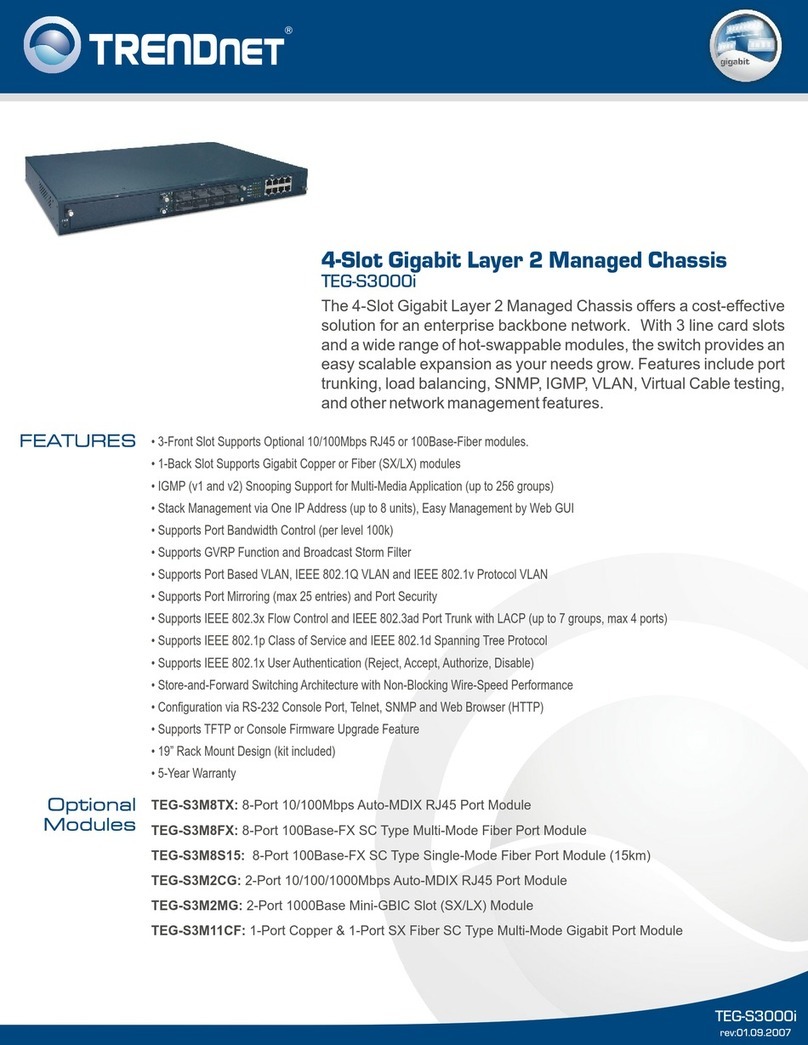
TRENDnet
TRENDnet TEG-S3000I - TEG Gigabit Layer 2 Managed Chassis S3000i... Specifications
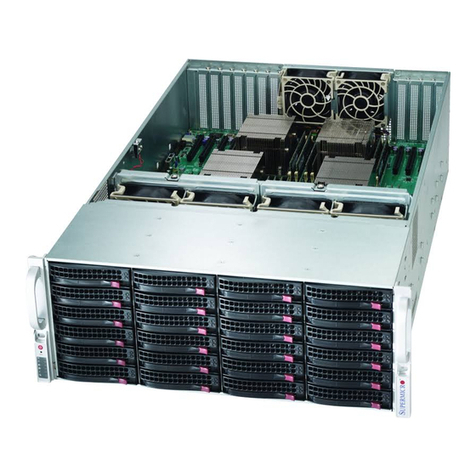
Supermicro
Supermicro SC848A-R1800B user manual
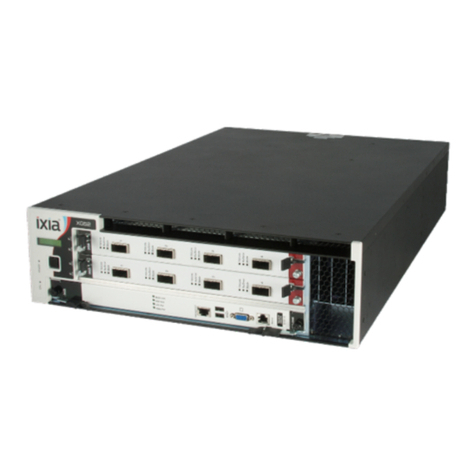
Keysight
Keysight Ixia IxOS XGS2 Series Getting started guide
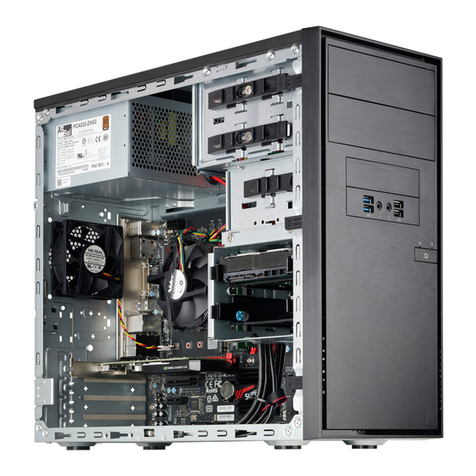
Supermicro
Supermicro SCDS3A-261B user manual
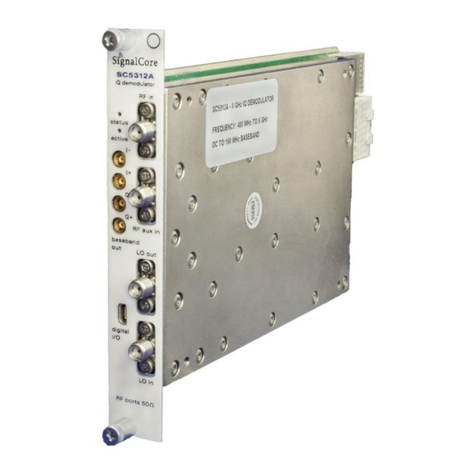
SIGNALCORE
SIGNALCORE SC5312A Operating and programming manual
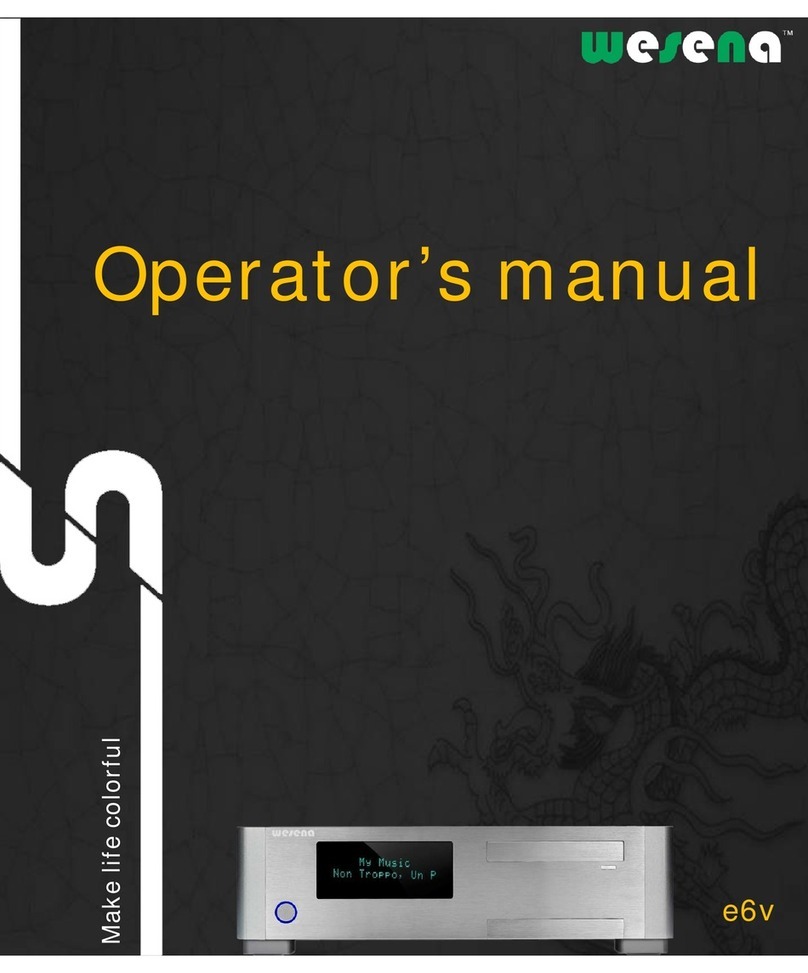
Wesena
Wesena e6V Operator's manual

nMedia
nMedia HTPC 280 BA Quick installation guide
Omnitron Systems
Omnitron Systems iConverter 8245-11pt user manual
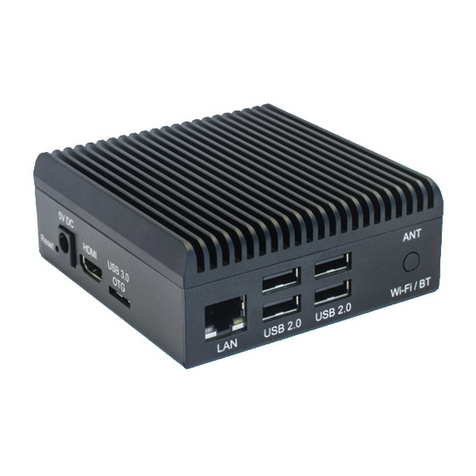
UP
UP UP-GWS01-A10-0001 Assembly instructions
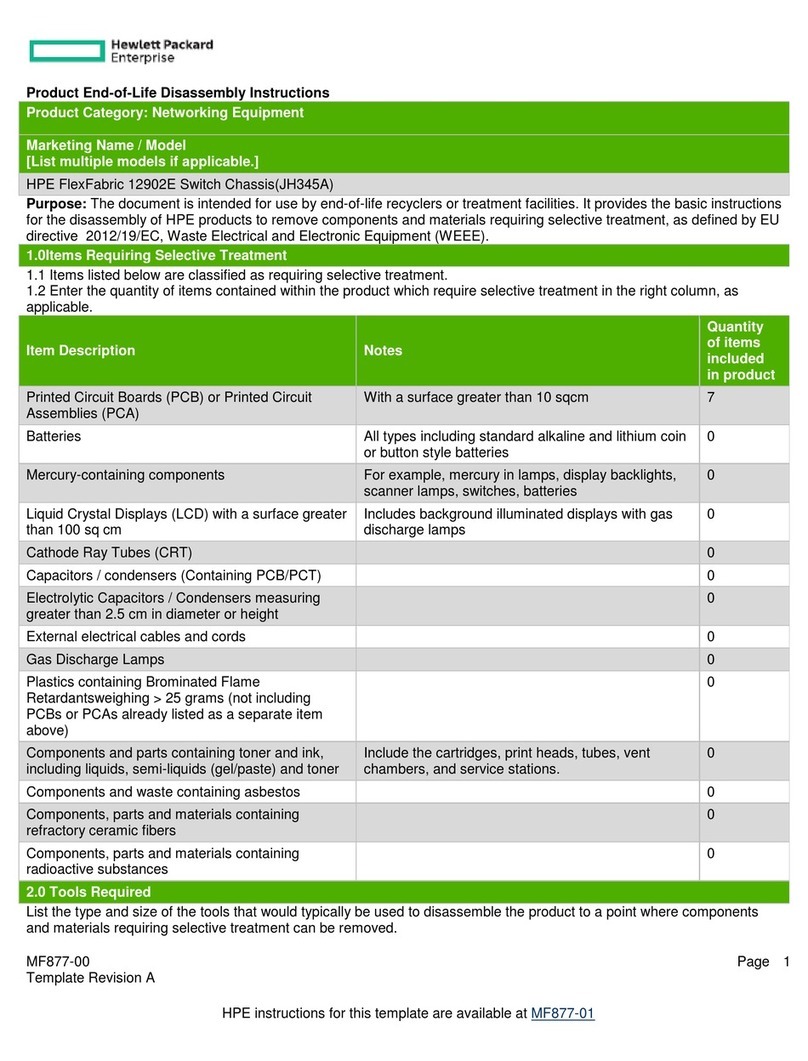
HPE
HPE FlexFabric 12902E Product End-of-Life Disassembly Instructions
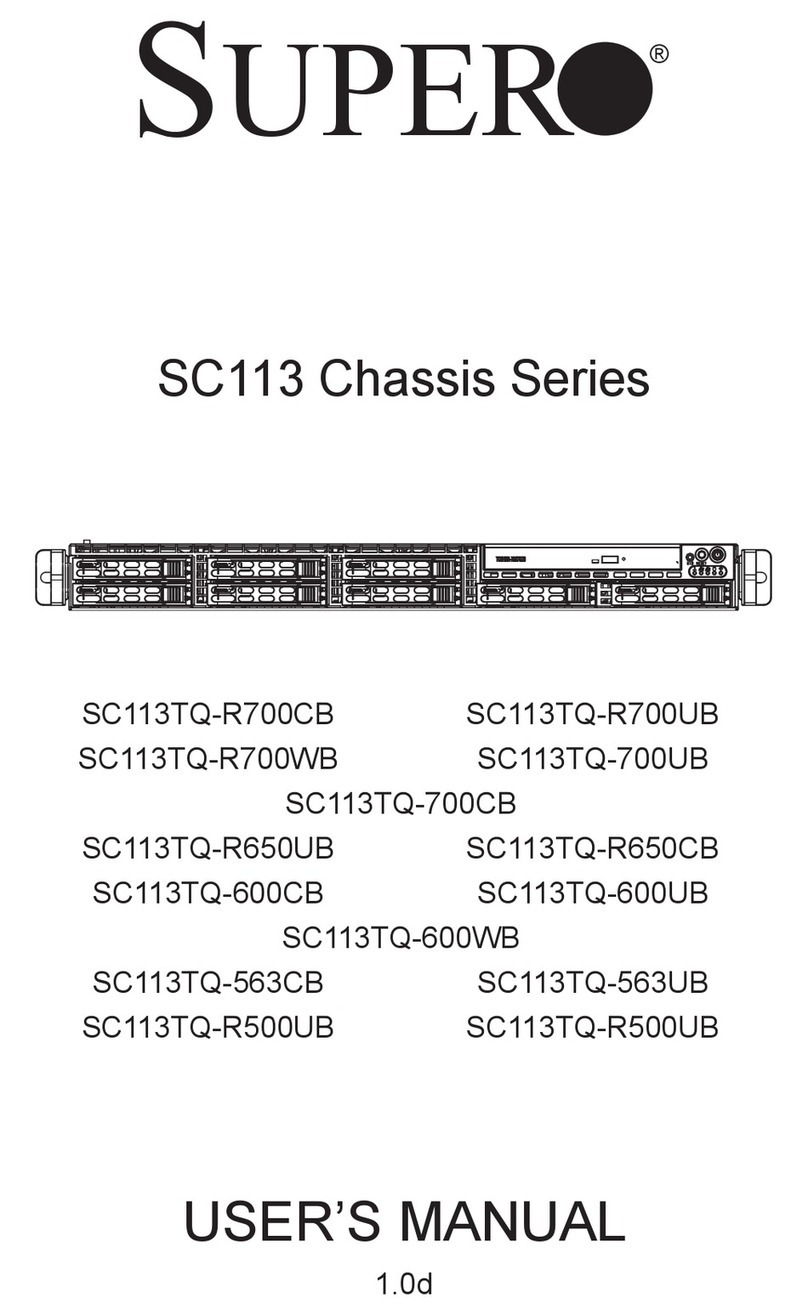
Supero
Supero SC113TQ-R700CB user manual
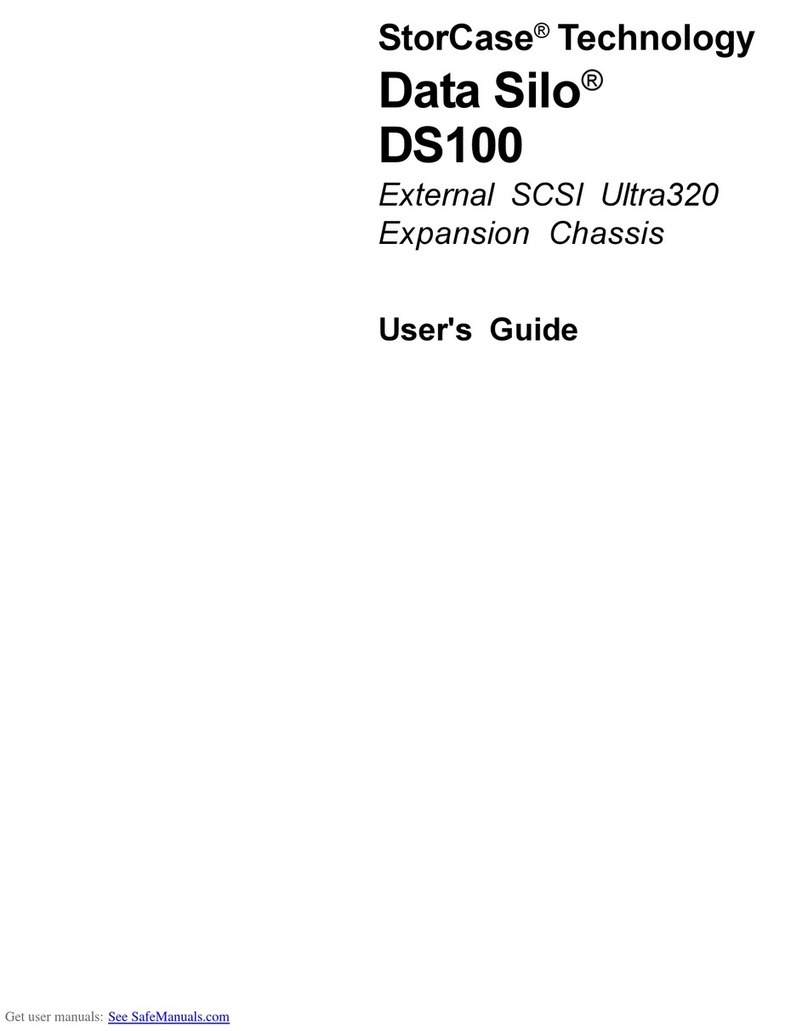
StorCase Technology
StorCase Technology Data Silo DS100 user guide
